Microstructural Evolution and Mechanical Properties of Cu–Ag Alloy via Different Severe Plastic Deformation Processes
Abstract
1. Introduction
2. Experimental
3. Results
3.1. Microstructural Characterization
3.2. Mechanical Properties
4. Discussion
4.1. Strengthening Mechanism of the Cryogenic Rolling Process
4.2. Multiple Strengthening Effect Contributions to the Yield Strength
- (1)
- Fine-grain strengthening
- (2)
- Dislocation strengthening
- (3)
- Precipitation strengthening
5. Conclusions
- (1)
- After room temperature and cryogenic rolling, the dendritic crystals of the Cu-28Ag alloy are significantly refined, and the Ag phase is distributed in fibrous layers. Cryogenic rolling improves the surface quality and dendritic refinement effect of the alloy, and the lamellar structure is more pronounced, indicating that this method is an effective means of regulating the microstructure of Cu-Ag alloys with high Ag content in the as cast state.
- (2)
- The conductivity of the alloy decreases after room temperature rolling and cryogenic rolling, mainly due to the increase in electron scattering particles in the matrix. The tensile strength of the alloy increases, but its elongation decreases. When the deformation of cryogenic rolling is 95%, the alloy exhibits good comprehensive mechanical properties, with ultimate tensile strength, yield strength, and elongation of 640 MPa, 631 MPa, and 1.9%, respectively.
- (3)
- The strengthening mechanism of the Cu-Ag alloy includes fine-grain strengthening, dislocation strengthening, and precipitation strengthening, and the results of the strength calculations show that the strength increments due to different strengthening mechanisms are basically equivalent, with the contribution of fine-grain strengthening being slightly higher.
- (4)
- After cryogenic rolling with a deformation amount of 95%, the alloy has a certain degree of uniform deformation ability, which is attributed to grain refinement, high-density dislocations with uniform distribution, the deformation texture, and the improvement in the heterogeneous induced deformation ability.
Author Contributions
Funding
Institutional Review Board Statement
Informed Consent Statement
Data Availability Statement
Conflicts of Interest
References
- Zhu, X.; Xiao, Z.; An, J.; Jiang, H.; Jiang, Y.; Li, Z. Microstructure and properties of Cu-Ag alloy prepared by continuously directional solidification. J. Alloys Compd. 2021, 883, 160769. [Google Scholar] [CrossRef]
- Sengul, S.; Guder, V. Key factors of deformation mechanism of Cu-Ag alloy. J. Non-Cryst. Solids 2022, 576, 121270. [Google Scholar] [CrossRef]
- Kong, L.; Zhu, X.; Xing, Z.; Chang, Y.; Huang, H.; Shu, Y.; Qi, Z.; Wen, B.; Li, P. Preparation and mechanisms of Cu–Ag alloy fibers with high strength and high conductivity. Mater. Sci. Eng. A 2024, 895, 146219. [Google Scholar] [CrossRef]
- Xie, M.; Huang, W.; Chen, H.; Gong, L.; Xie, W.; Wang, H.; Yang, B. Microstructural evolution and strengthening mechanisms in cold-rolled Cu–Ag alloys. J. Alloys Compd. 2021, 851, 156893. [Google Scholar] [CrossRef]
- Wu, Y.; Zhang, W.; Li, Y.; Yang, F.; Liu, H.; Zou, J.; Jiang, J.; Fang, F.; Ma, A. An overview of microstructure regulation treatment of Cu-Fe alloys to improve strength, conductivity, and electromagnetic shielding. J. Alloys Compd. 2024, 1002, 175425. [Google Scholar] [CrossRef]
- Wang, W.; Xiao, Z.; Lei, Q.; Meng, H.; Guo, Q.; Yang, Y.; Li, Z. A multiphase strengthened Cu-Nb-Si alloy with high strength and high conductivity. Mater. Charact. 2021, 182, 111565. [Google Scholar] [CrossRef]
- Wang, W.; Zhu, J.; Qin, N.; Zhang, Y.; Li, S.; Xiao, Z.; Lei, Q.; Li, Z. Effects of minor rare earths on the microstructure and properties of Cu-Cr-Zr alloy. J. Alloys Compd. 2020, 847, 155762. [Google Scholar] [CrossRef]
- Zhao, C.; Niu, R.; Xin, Y.; Brown, D.; McGuire, D.; Wang, E.; Han, K. Improvement of properties in Cu–Ag composites by doping induced microstructural refinement. Mater. Sci. Eng. A 2021, 799, 140091. [Google Scholar] [CrossRef]
- Lin, J.; Meng, L. Effect of aging treatment on microstructure and mechanical properties of Cu–Ag alloys. J. Alloys Compd. 2008, 454, 150–155. [Google Scholar] [CrossRef]
- Xie, M.; Zhou, P.; Huang, W.; Chen, H.; Gong, L.; Xie, W.; Wang, H.; Yang, B. Annealing effects on the microstructure, strength, and electrical resistivity in a dual-phase Cu-15 wt%Ag alloy. Mater. Sci. Eng. A 2022, 840. [Google Scholar] [CrossRef]
- Nguyen, D.N.; Hoang, A.T.; Pham, X.D.; Sai, M.T.; Chau, M.Q.; Pham, V.V. Effect of Sn component on properties and microstructure Cu-Ni-Sn alloys. J. Teknol. 2018, 80, 43–51. [Google Scholar] [CrossRef]
- Zuo, X.; Han, K.; Zhao, C.; Niu, R.; Wang, E. Precipitation and dissolution of Ag in ageing hypoeutectic alloys. J. Alloys Compd. 2015, 622, 69–72. [Google Scholar] [CrossRef]
- Guo, X.; Zhang, L.; Zhang, D.; Li, Y.; Zhao, X.; Wang, E. Effect of Cr addition on the microstructure evolution, precipitation behavior and properties of Cu–Ag alloy. Mater. Sci. Eng. A 2024, 894, 146186. [Google Scholar] [CrossRef]
- Shi, P.; Shen, Z.; Wang, H.; Li, Z.; Gu, Y.; Yan, J.; Lin, Z.; Wang, M.; Yang, Y.; Ling, C.; et al. Bioinspired, heredity-derived hierarchical bulk multifunctional copper alloys. Mater. Today 2023, 71, 22–37. [Google Scholar] [CrossRef]
- Cao, Y.; Ni, S.; Liao, X.; Song, M.; Zhu, Y. Structural evolutions of metallic materials processed by severe plastic deformation. Mater. Sci. Eng. R Rep. 2018, 133, 1–59. [Google Scholar] [CrossRef]
- An, Z.; Mao, S.; Liu, Y.; Yang, L.; Vayyala, A.; Wei, X.; Liu, C.; Shi, C.; Jin, H.; Liu, C.; et al. Inherent and multiple strain hardening imparting synergistic ultrahigh strength and ductility in a low stacking faulted heterogeneous high-entropy alloy. Acta Mater. 2023, 243, 118516. [Google Scholar] [CrossRef]
- Yang, H.; Wu, L.; Jiang, B.; Liu, W.; Song, J.; Huang, G.; Zhang, D.; Pan, F. Clarifying the roles of grain boundary and grain orientation on the corrosion and discharge processes of α-Mg based Mg-Li alloys for primary Mg-air batteries. J. Mater. Sci. Technol. 2021, 62, 128–138. [Google Scholar] [CrossRef]
- Xu, W.; Xin, Y.; Zhang, B.; Li, X. Stress corrosion cracking resistant nanostructured Al-Mg alloy with low angle grain boundaries. Acta Mater. 2022, 225, 117607. [Google Scholar] [CrossRef]
- Rui, S.-S.; Han, Q.-N.; Wang, X.; Li, S.; Ma, X.; Su, Y.; Cai, Z.; Du, D.; Shi, H.-J. Correlations between two EBSD-based metrics Kernel Average Misorientation and Image Quality on indicating dislocations of near-failure low alloy steels induced by tensile and cyclic deformations. Mater. Today Commun. 2021, 27, 102445. [Google Scholar] [CrossRef]
- Liu, S.; Liu, H.; Chen, X.; Huang, G.; Zou, Q.; Tang, A.; Jiang, B.; Zhu, Y.; Pan, F. Effect of texture on deformation behavior of heterogeneous Mg-13Gd alloy with strength–ductility synergy. J. Mater. Sci. Technol. 2022, 113, 271–286. [Google Scholar] [CrossRef]
- Fan, J.; Ji, X.; Fu, L.; Wang, J.; Ma, S.; Sun, Y.; Wen, M.; Shan, A. Achieving exceptional strength-ductility synergy in a complex-concentrated alloy via architected heterogeneous grains and nano-sized precipitates. Int. J. Plast. 2022, 157, 103398. [Google Scholar] [CrossRef]
- Ren, R.; Fan, J.; Wang, B.; Zhang, Q.; Li, W.; Dong, H. Hall-Petch relationship and deformation mechanism of pure Mg at room temperature. J. Alloys Compd. 2022, 920, 165924. [Google Scholar] [CrossRef]
- Hall, E. The deformation and ageing of mild steel: III discussion of results. Proc. Phys. Society. Sect. B 1951, 64, 747. [Google Scholar] [CrossRef]
- Petch, N.J. The cleavage strength of polycrystals. J. Iron Steel Res. Int. 1953, 174, 25–28. [Google Scholar]
- Tong, Y.-X.; Li, S.-Y.; Zhang, D.-T.; Li, L.; Zheng, Y.-F. High strength and high electrical conductivity CuMg alloy prepared by cryorolling. Trans. Nonferrous Met. Soc. China 2019, 29, 595–600. [Google Scholar] [CrossRef]
- Kusakin, P.; Belyakov, A.; Haase, C.; Kaibyshev, R.; Molodov, D.A. Microstructure evolution and strengthening mechanisms of Fe–23Mn–0.3C–1.5Al TWIP steel during cold rolling. Mater. Sci. Eng. A 2014, 617, 52–60. [Google Scholar] [CrossRef]
- Zhang, X.; Hansen, N.; Godfrey, A.; Huang, X. Dislocation-based plasticity and strengthening mechanisms in sub-20 nm lamellar structures in pearlitic steel wire. Acta Mater. 2016, 114, 176–183. [Google Scholar] [CrossRef]
- Lei, Q.; Xiao, Z.; Hu, W.; Derby, B.; Li, Z. Phase transformation behaviors and properties of a high strength Cu-Ni-Si alloy. Mater. Sci. Eng. A 2017, 697, 37–47. [Google Scholar] [CrossRef]
- Luo, B.; Li, D.; Zhao, C.; Wang, Z.; Luo, Z.; Zhang, W. A low Sn content Cu-Ni-Sn alloy with high strength and good ductility. Mater. Sci. Eng. A 2019, 746, 154–161. [Google Scholar] [CrossRef]
- Jun, J.-H. Dependence of hardness on interlamellar spacing of discontinuous precipitates in cast AZ91 magnesium alloy. J. Alloys Compd. 2017, 725, 237–241. [Google Scholar] [CrossRef]
- Jiang, H.; Peng, L.; Mi, X.; Guo, H.; Xie, H.; Liu, D.; Liu, F.; Yang, Z. Simultaneously enhancing the strength and electrical conductivity of Cu-Ni-Sn alloy through plastic deformation of an intermetallic compound. Mater. Des. 2023, 235. [Google Scholar] [CrossRef]
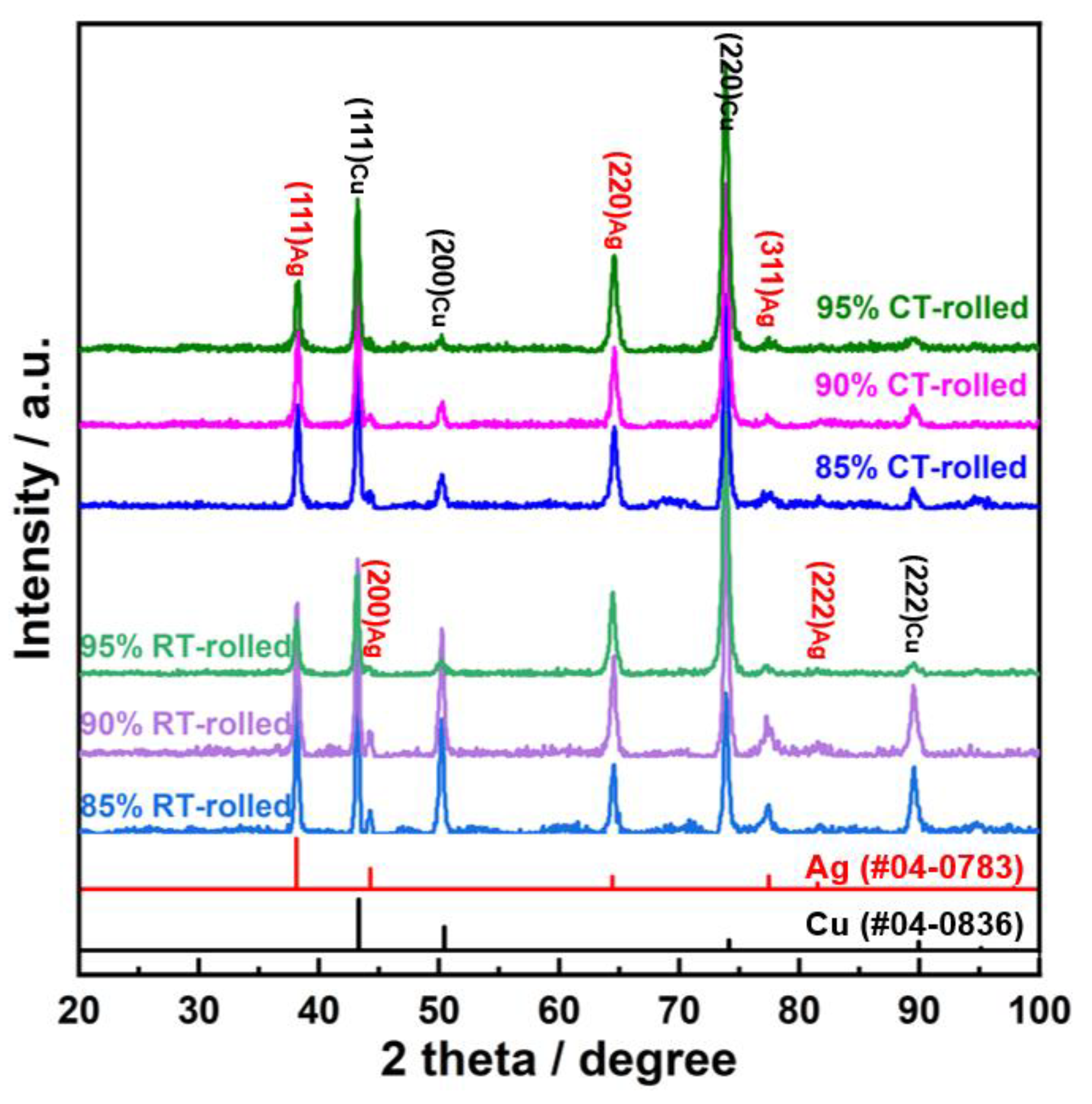

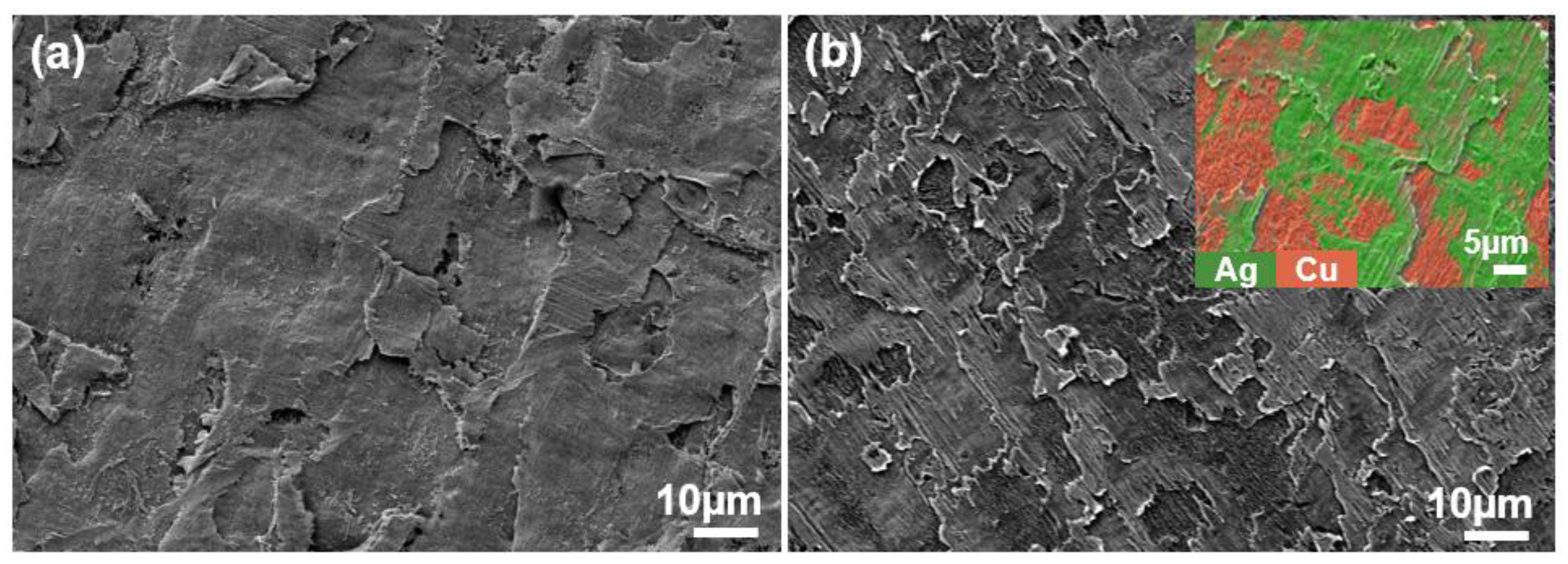
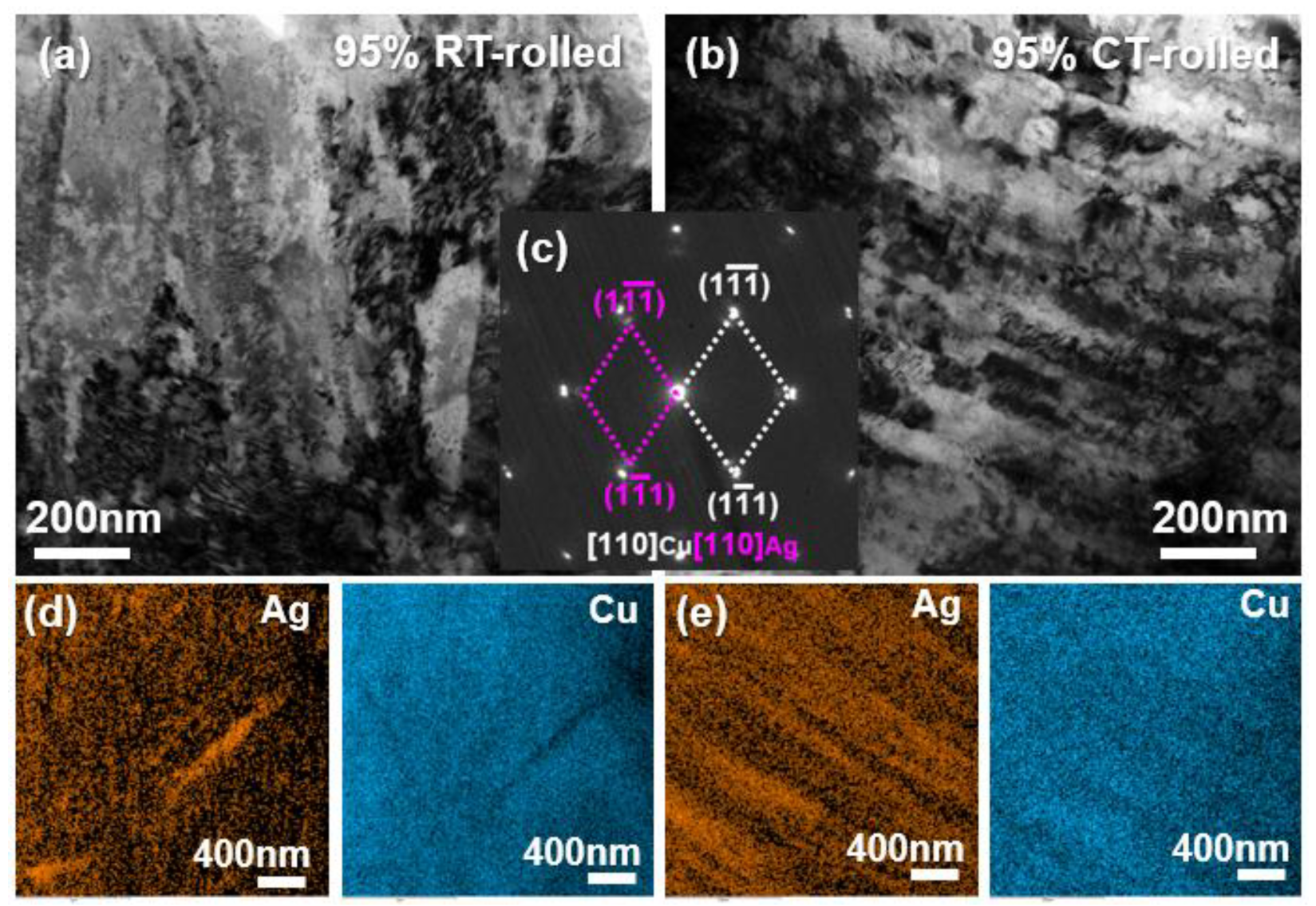

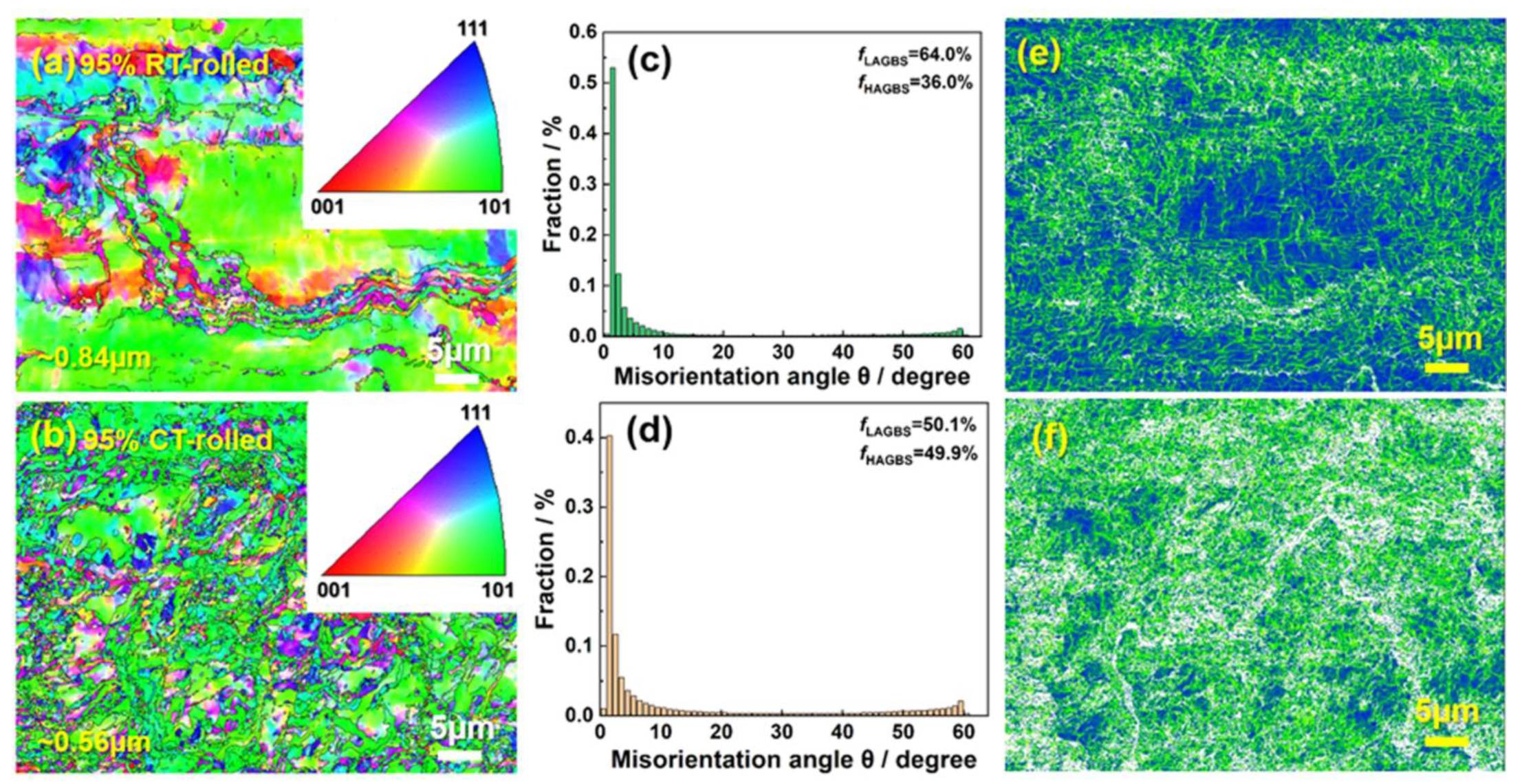
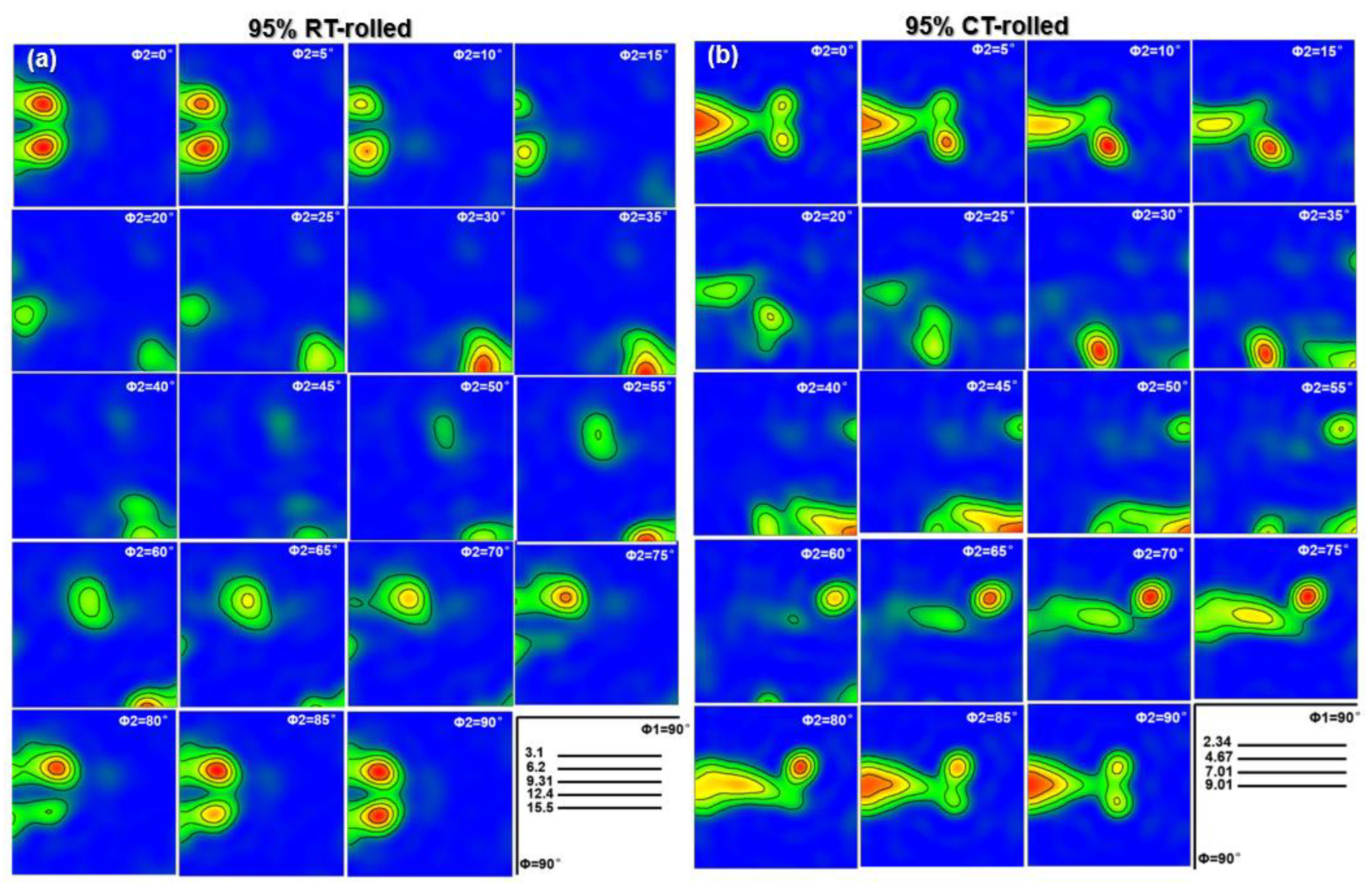
| Alloy | σUTS/MPa | σYS/MPa | δ/% | Electric Conductivity/%IACS |
|---|---|---|---|---|
| 85% RT-rolled | 553 ± 15 | 506 ± 12 | 3.15 ± 1.21 | 86.45 ± 1.15 |
| 90% RT-rolled | 561 ± 13 | 473 ± 20 | 2.60 ± 0.90 | 85.38 ± 0.75 |
| 95% RT-rolled | 602 ± 18 | 597 ± 18 | 1.45 ± 1.02 | 82.40 ± 0.85 |
| 85% CT-rolled | 583 ± 10 | 539 ± 21 | 2.55 ± 1.32 | 79.55 ± 0.95 |
| 90% CT-rolled | 588 ± 16 | 542 ± 22 | 2.35 ± 0.95 | 79.04 ± 1.28 |
| 95% CT-rolled | 640 ± 20 | 631 ± 25 | 1.90 ± 1.50 | 69.63 ± 0.85 |
Disclaimer/Publisher’s Note: The statements, opinions and data contained in all publications are solely those of the individual author(s) and contributor(s) and not of MDPI and/or the editor(s). MDPI and/or the editor(s) disclaim responsibility for any injury to people or property resulting from any ideas, methods, instructions or products referred to in the content. |
© 2025 by the authors. Licensee MDPI, Basel, Switzerland. This article is an open access article distributed under the terms and conditions of the Creative Commons Attribution (CC BY) license (https://creativecommons.org/licenses/by/4.0/).
Share and Cite
Li, H.; Xie, H.; Zhao, Y.; Zhang, W.; Huang, L.; Yuan, Y.; Chu, H.; Mi, X. Microstructural Evolution and Mechanical Properties of Cu–Ag Alloy via Different Severe Plastic Deformation Processes. Materials 2025, 18, 581. https://doi.org/10.3390/ma18030581
Li H, Xie H, Zhao Y, Zhang W, Huang L, Yuan Y, Chu H, Mi X. Microstructural Evolution and Mechanical Properties of Cu–Ag Alloy via Different Severe Plastic Deformation Processes. Materials. 2025; 18(3):581. https://doi.org/10.3390/ma18030581
Chicago/Turabian StyleLi, Haifeng, Haofeng Xie, Yizhi Zhao, Wenjing Zhang, Lue Huang, Yi Yuan, Hao Chu, and Xujun Mi. 2025. "Microstructural Evolution and Mechanical Properties of Cu–Ag Alloy via Different Severe Plastic Deformation Processes" Materials 18, no. 3: 581. https://doi.org/10.3390/ma18030581
APA StyleLi, H., Xie, H., Zhao, Y., Zhang, W., Huang, L., Yuan, Y., Chu, H., & Mi, X. (2025). Microstructural Evolution and Mechanical Properties of Cu–Ag Alloy via Different Severe Plastic Deformation Processes. Materials, 18(3), 581. https://doi.org/10.3390/ma18030581






